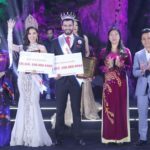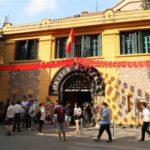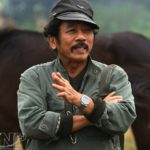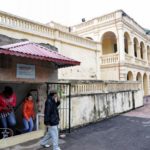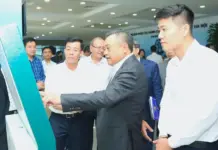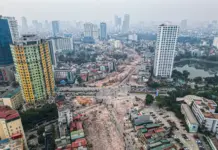In recent years, many South Koreans have traveled to Vietnam in an effort to ameliorate the lingering effects of war.
They have constructed schools, provided scholarships, and planted trees in a concerted effort to foster peace and reconciliation.
“We did not come to Vietnam to merely remember the heartbreaking events of the past,” declared South Korean lawmaker Kang Min Jung in a speech on February 14th at the Ha My memorial. The monument, located in Dien Ban Town’s Dien Duong Ward in Quang Nam Province, is dedicated to the victims of the 1968 Ha My Massacre.
”
We sought to gain a greater understanding of the reality of what our ancestors endured.
”
For us and for many other South Koreans, it is of the utmost importance to uncover the truth.
”
After gaining a greater understanding of this reality, we can then extend our sympathies and provide comfort to the family and friends of the deceased victims.
We would like to express our solidarity with those who have experienced suffering and hardship for many years.
A Message of Peace
The world we live in is filled with turmoil and unrest. But there is one constant that can bring us all together – peace. We need to come together to create a world where we can all live in harmony and understanding, free from conflict and violence. Let us strive to spread a message of peace and understanding, to make this world a better place for us all.
Kang, who traveled to Ha My with 36 other South Koreans, said that the knowledge that her fellow countrymen were responsible for the deaths of so many, including newborns, is unspeakably upsetting, even though she herself was not involved in the massacre.
“It pains my soul to know that so many Vietnamese people had to endure beyond their means,” Kang lamented.
We come here to apologize for our [country’s] past wrongdoings, for something that should never have happened. With these trips, we endeavor to assuage the pain of the loved ones of those who perished in the war.”
On January 25, 1968, South Korea’s Green Dragon Brigade perpetrated a ruthless massacre in the small village of Ha My. In a devastating display of brutality, the brigade ruthlessly slaughtered 135 villagers, with the majority of those killed being elderly, women, and children. To add to their horrors, the troops then set fire to the village, leaving behind only smoldering ruins.
On February 15, 2023—55 years after the tragic massacre—Kang and her group of 37 lawyers, students, and lawmakers returned to Ha My bearing gifts for the villagers and to pray over the gravestones of the 135 victims.
While the wounds of history can never be erased, the South Korean visitors hoped their presence in Ha My would aid in the healing of those who continue to experience pain.
Kang and her team of dedicated volunteers are part of the Korea-Vietnam Peace Foundation – a non-profit, non-governmental organization founded in September 2016 to draw attention to and rectify the wrongs committed by Koreans during the war in Vietnam. Through their work, the Foundation strives to promote peace and reconciliation while honoring the memories of those affected by the war.
As part of their work, the group plans annual trips to Ha My and other villages that experienced similar devastating events. This helps them better understand the lasting impacts of war and how they can continue to support affected communities in the future.
When they are unable to make a trip, they collaborate with local authorities to ensure that offerings are still made at local memorials.
During this year’s trip to Ha My, the group was joined by eighty relatives of the victims.
“It is with great shame and sorrow that I stand before you today,” uttered Kim Chang Sup, head of the Korea-Vietnam Peace Foundation delegation, as he read an apology letter at the Ha My memorial. “We apologize to all of you who have felt the pain of war every spring, and to those who have been faithfully lighting incense sticks here for the past 55 years.”
|
Kim Chang Sup, a member of the Korea-Vietnam Peace Foundation, was overcome with emotion when he read an apology letter at a ceremony held to commemorate the victims of the Ha My Massacre. A photo of the touching moment was captured by B.D. from Tuoi Tre. Tears streamed down his face, and the heartfelt apology was a powerful reminder of the tragedy that had taken place. |
| Kim Chang Sup, a member of the Korea-Vietnam Peace Foundation, burst into tears as he read an apology letter at a ceremony held to commemorate the victims of the Ha My Massacre. Photo: B.D. / Tuoi Tre |
Transforming Bomb Craters into Schools and Parks
The war-torn countries of the world have seen their fair share of destruction, leaving behind a legacy of destruction. One of the most visible and tragic reminders of conflict are the bomb craters that are scattered across the landscape. But, there is hope. A new movement is emerging that seeks to transform these areas of destruction into places of learning, recreation, and growth. By turning bomb holes into schools and parks, these communities can create a better future for their children and help bring a sense of normalcy back to their lives.
Through the building of schools and parks, communities can create places for their children to learn, play, and grow. These facilities can also provide employment opportunities and help to boost the local economy. Additionally, the presence of these facilities can serve as a reminder of the horrors of war and inspire citizens to work together for peace and reconciliation.
By transforming bomb craters into schools and parks, we can help to create a brighter future for the affected communities. It is our hope that this movement will continue to grow and that these places will become a beacon of hope for those affected by war.
Despite its tumultuous past, local residents of Ha My have managed to overcome the devastation in order to transform the area into a thriving village, according to Nguyen Van Tuan, head of the Dien Duong Ward People’s Committee. With great courage and determination, the inhabitants of Ha My have been able to turn their once-desolate village into a prosperous one.
Some of the success of Korea and Vietnam in rebuilding their relationship is due, in part, to organizations such as the Korea-Vietnam Peace Foundation.
Many years ago, an Apologies to Vietnam movement developed in South Korea, inspiring many to visit Vietnam to make amends for the sins of their countrymen. Media reports on the Ha My massacre and other horrific events encouraged South Koreans to construct memorials, fund scholarships, and build playgrounds for local schools.
Huyn Woo Kwon, the head of the Korea-Vietnam Peace Foundation, is the nephew of a South Korean who was stationed in Vietnam during the war. However, it was not until South Korean media published reports on the various massacres committed by South Korean troops that he realized the need to make reparations for his country. By taking action, Kwon is working to improve the strained relations between the two nations and to make amends for the suffering caused by his nation. His dedication to peace and reconciliation is an example of his commitment to bridging the gap between the two countries.
“My uncle was so angry when I questioned him about the actions of South Korean troops during the Vietnam War,” Kwon recollected. “I had come to Vietnam to uncover the truth behind the war and to attempt to repair any wrongdoings that may have occurred.”
To gain a deeper understanding of the impact South Koreans had on Vietnam during the war, Huyn relocated to Ho Chi Minh City to attend university. Even more remarkable, he had his first child while living in the country.
He eventually began making regular trips to the sites of massacres in Quang Nam, Quang Ngai, and Binh Dinh Provinces in order to promote projects aimed at constructing schools and parks, as well as to pay his respects to the relatives of victims.
His dedication to atoning for his country’s wrongdoings earned him much admiration from the Vietnamese locals and authorities he befriended during these trips.
Eventually, they affectionately bestowed upon him the Vietnamese name “Vu”.
According to Vu, the Korea-Vietnam Peace Foundation has launched meaningful projects in various massacre areas, including the construction of four parks at four schools in Binh Dinh and two playgrounds for students in Dien Duong Ward. Moreover, dozens of intellectuals and students from South Korea have been making regular visits to the sites.
In 2020, the Korea-Vietnam Peace Foundation allocated part of their funds to local authorities in order to build the Ha My memorial. This memorial will serve as a reminder of the countries’ shared history and help to further strengthen the bond between Vietnam and Korea.
During the foundation’s trips to the memorials, the South Korean group typically brings special gifts to the people of Vietnam, including scholarships for low-income students and handwritten letters from South Korean students who wish to express their sincere apologies for the past. Through these actions, they hope to help mend the strained relationship between the two countries.
“The suffering endured by the Vietnamese people is immense and can never be fully healed,” Vu declared.
”
We want to come here to take on the responsibility, in the hopes of bringing comfort to the families and the souls of the victims.
We strive to do our utmost and are committed to supporting the aspirations of today’s students towards peace and development through investments in parks and scholarships.
Kneeling in apology is a gesture of humility and regret. It is a sign of contrition and a way of showing remorse for a wrong committed. It can be used to express sincere apologies or to make amends for a mistake or misdeed. Kneeling in apology is often seen as a sign of respect and humility, and is often used to express remorse or to seek forgiveness. It is also a way to show humility and recognition of the wrong done, and to demonstrate a commitment to making reparations. Kneeling in apology is an ancient practice that is still seen in many cultures as a symbol of respect and humility.
From February 12th to 14th, 37 members of the Korea-Vietnam Peace Foundation visited sites in Quang Nam Province that had been home to horrific massacres perpetrated by South Korean soldiers.
The group journeyed to Quang Nam to pay their respects and honor the victims by burning incense at a local memorial. They also took the time to meet with families of the deceased to offer their condolences.
On the morning of February 12, families, local authorities, and members of the community gathered to commemorate the 135 villagers who were tragically killed in Tay Hamlet, Ha My Village, 55 years ago. This solemn occasion was marked with a moment of silence and the laying of wreaths to honor the lives of those lost. The ceremony served as a reminder of the importance of peace and the fragility of life.
At the ceremony, 37 South Koreans – including lawyers, lawmakers, and students – knelt in apology to the people who currently inhabit the site of the massacre.
Kim Chang Sup, the head of the delegation, read an apology letter expressing regret for the actions of the South Korean army in Vietnam. The letter acknowledged the deep pain and suffering that the actions had caused.
Kim promised to do everything in his power to make up for his country’s wartime mistakes and alleviate the suffering of the villagers.
and chair of the Korean-Vietnam Friendship Association.
“South Korea-Vietnam relations have both a bright and dark side,” said Kang Min Jung, the chair of the South Korean-Vietnam Friendship Association and a South Korean lawmaker.
”
The “light side” is the vibrant exchange of ideas, resources, and experiences between different realms such as the economy, culture, and society.
”
The ‘dark side’ of South Korean involvement in the Vietnam War caused immense suffering and long-lasting pain.
We have come here today to apologize for our wrongdoings, heal the wounds of war, and foster peace. By doing so, we can strive to create a lasting and meaningful peace for generations to come. Our actions today can help to bring about a brighter future for all.
Like us on Facebook or follow us on Twitter to stay updated on the latest news about Vietnam!
Writer Chu Lai: War and Literature
The war in Vietnam has been over for nearly 40 years and many soldiers have returned home with unforgettable memories. One of them is Chu Lai, a prolific author who has not only won the people’s respect for his famous stories about war and the post-war era, but also for his dramatic stage and movie work.
Secret War Bunker in Thang Long Citadel
The underground bunker is located west of the Department of Operations, the General Staff of the Vietnam’s People Army in the imperial citadel of Thang Long in downtown Hanoi. It played an important role in the American war, especially during the 12 days and nights of the Hanoi-Dien Bien Phu air battle 40 years ago. Recently, the bunker was restored by the Thang Long Heritage Preservation Centre and was officially opened to tourists.


